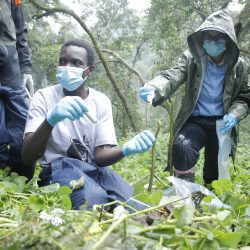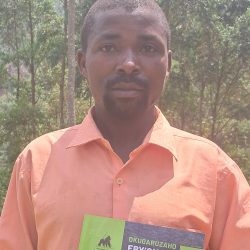Cleaning Volcanoes National Park: Removing remnants from the past
Blog | 30/09/11
Over a hundred sacks of trash- discarded tins of tomato paste, sacks, clothes, and more- were removed from Volcanoes National Park in just two days of a renewed effort by IGCP to clean the park of waste and exotic plant species left by people.
What follows is a post written by IGCP’s Conservation Incentives Officer Benjamin Mugabukomeye about this important process. This post was translated from French to English.
In 1999, IGCP organized a thorough cleaning of Volcanoes National Park in Rwanda, primariliy in the central part of the park- Nyange, Kinigi, and Singiro- following a return to security after the conflict in Rwanda in the early 1990s in which many people and militias took refuge in the same forests that were and continue to be a refuge for mountain gorillas.
Now, in 2011, IGCP is again facilitating, thanks to support from Partners in Conservation, the cleaning of the Volcanoes NP in areas where there is a large concentration of waste- specifically, the Districts of Nyabihu and Rubavu. Large quantities of waste were noted by the teams conducting the census of mountain gorillas last year.
In the last several months, IGCP worked with the Rwanda Development Board (RDB) who manages the park to do a more detailed identification of these locations and prepare a distribution map. This map allows us to prioritize and keep track of our work and will feed into the monitoring of the park by RDB.
The next step was to negotiate contracts with AMIZERO, an association of former poachers, and finally we started the activity itself.
Before entering the Park participants receive a briefing on the behavior inside the park but not only that but also the importance of this activity and the impact of exotic species on biodiversity in the park.
The cleanup of the Karisimbi trail began Thursday in theKabatwa area of Nyabihu District at the foot of volcanoes Karisimbi. A team of 48 people participated in this activity. During this first day we cleaned the Karisimbi trail, and its surroundings despite the heavy rain, the participants were collected more waste as you can see in the pictures. During the first day over 48 bags of garbage were collected.
As you see in the photos that there was a lot of waste because of the movement of people on it. This has made it necessary to establish a long-term strategy to reduce waste within the Park.
The most common wastes were plastic and canvas bags, boxes and tins of tomato sauce, old clothes, etc.
On the second day I had the opportunity to participate in cleanup activities in the same area, and more than 60 people were involved. On this day we not only picked up trash, but reduced the number of papaya trees that were growing exotically in the park. On the second day over 60 bags were collected by participants in the same area.

Benjamin Mugabukomeye, Conservation Incentives Officer for IGCP chops down papaya growing within the park.
According to information provided by the local population and some former guards of Volcanoes National Park, the spread of this plant has been exacerbated by the insecurity that has prevailed in this area in the years 1997 to 1999 that led some people to take refuge in the park. Papaya being in the forest is also a source of conflict is not good in many ways, especially as children enter the park to look for the papayas.
Despite the fatigue due to the difficult work, most participants left very happy to have cleaned up the park in collaboration with RDB and its partners, they find this activity as a great lesson to the members of their union by showing them how the environment is very fragile.
We will report via this blog in the coming months the area cleaned by this effort and the amount of trash removed.
Thanks to Partners in Conservation at the Columbus Zoo and Aquarium in the United States for funding this project.








